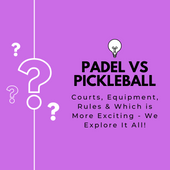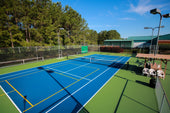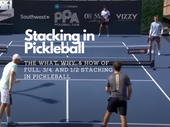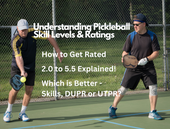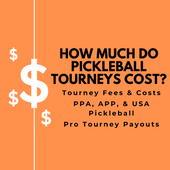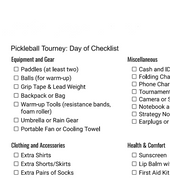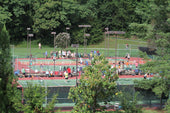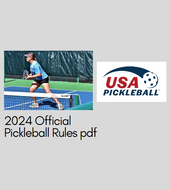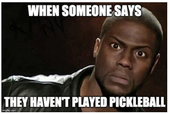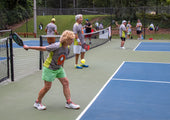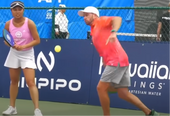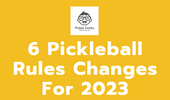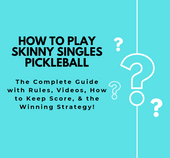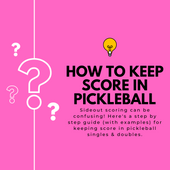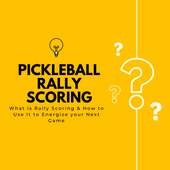One of the beautiful things about pickleball is that anyone can play it, no matter their age, fitness, or ability level.
If you’re looking to start your pickleball journey, know that pickleball has a few quirky rules. From the mysterious “kitchen” to 3 digit scoring (4-2-2?) to ATPs and ERNEs, pickleball has a unique set of lingo and regulations that need to be mastered.
To help you make the most out of your time on the court, this guide will cover all of the basic rules of pickleball, including:
- The 5 fundamental pickleball rules for beginners
- Scoring and serving rules
- Pickleball doubles rules
- Pickleball singles rules
- The “Kitchen” rules
- A link to the Official USA Pickleball Handbook 2023 (PDF version)
With an understanding of these rules, you’ll be ready to dink and drive your way to pickleball success!
Ready? Let's pickle!!
Basic Pickleball Rules for Beginners: Summary
There are 5 most important rules you’ll need to know in order to make the most of your time on a pickleball court:
1) Out of Bounds
Like tennis, pickleball is played on a court with boundary lines. When hitting the pickleball into your opposition’s half of the court, the ball must bounce “inbounds”, which means inside or on the outermost lines of the court.

2) The “Kitchen”
The “kitchen”, officially known as the no volley zone, is the 7-foot section of the court closest to the net. Players can not volley the pickleball out of the air while touching or standing in the kitchen or on the kitchen line.
3) Serving
In pickleball, all serves must be underhand and land on the side of the court diagonal to the server (crosscourt). Serves can not land in the “kitchen”, nor can they touch the kitchen line, but any other line is a legal landing spot for a serve.
4) Double Bounce Rule
Also known as the two bounce rule, this rule says that the 1st 2 shots in a rally must bounce off the ground before being struck, meaning they can not be volleyed in the air.
Put another way, after a serve is hit, the team returning the serve must let the ball bounce once before hitting it (the first bounce), and the serving team must let this shot bounce once before returning it (the second bounce).
Here's an example - notice how the 2 shots after the serve are both allowed to bounce, but after that the player volleys the next ball out of the air. The prior 2 balls had bounced on the ground so it was then legal to volley a ball:
This rule prevents teams from rushing the net and getting an unfair advantage too early in the rally.
5) Pickleball Scoring
Pickleball’s scoring system is called “sideout” scoring. Games are usually played to 11, with the winner having to win by at least two points.
Beginners should also be aware of the following rules before playing their first game of pickleball:
- Points can only be won by the serving team.
- The game’s first serve is to be taken from the right side of the court and hit diagonally into the right side of the opponent's half of the court (crosscourt).
- If a serve lands on the “kitchen” line, it is considered a fault (out). However, if a serve touches any other line (center line, service line, or sideline) in the correct diagonal area of the court it is considered in.
Pickleball Serve Rules
Now that we’ve covered the basics, it’s time to delve a bit deeper into the specifics of the rules of pickleball! First up - the serving rules:
- Serves must be underhand, with the ball at or below the waist when it is struck (i.e., overhand serves are illegal).
- Serves are always hit diagonally into the opponent’s half of the court.
Here's a quick 30 second clip on the basic serve rules:
- The first serve of the game must be hit from the right side of the server’s half of the court into the right side of the opponent’s half of the court (the diagonal side).
- Serves must land on (or within) the boundary lines of the diagonal side of the court to be playable.
- However, serves that land in the ”kitchen” – or on the kitchen line – are considered faults. Any other ball in a rally that touches this (or any other) line will be considered live (in), though.

Finally, serves that hit the net (called a let in tennis) on the way over are “live” as long as they land in the correct area of the court.
Pickleball Scoring Rules
Next up are the rules regarding scoring in pickleball!
There are a couple of key things to know here:
- Pickleball uses “sideout” scoring, which is similar to volleyball. The vast majority of pickleball games are played to 11, where the winner has to win by at least two points.
- If the leading player reaches 11 points and the trailing player has 10, the leading player must score one more point in order to win the game.
- Points can only be won by the server or serving team in pickleball.
- In singles games, when the score is called by the server, two digits are called: the server’s score and the receiver’s score. For example, if the server has 2 points and the returner 1, the score is 2 - 1.
- In doubles games, both players on each team get the chance to serve on their team’s service chance. So when the score is called out, three digits are called: the serving team’s score, the receiving team’s score, and the server serving that round (either a 1 or a 2).
- For example, if the serving team leads 2 to 1 and the 1st server on the team is serving, the score is called out 2-1-1. Since this can be confusing we’ll go into this in a little more detail later in the post!
Pickleball Doubles Rules
Here are the basic rules of doubles:

On the first serve turn of a game, the server on the right side will continue serving as long as his or her team wins points. When the serving team wins the point, the serving team players swap sides and the same player serves again to the other side of the court.
The opposing team players do not switch sides of the court when returning!
Once the receiving team wins a rally it is a sideout and their turn to serve.
On each service turn after the 1st service turn to start the game, the 1st server continues serving as long as his or her team continues winning points, switching sides of the court after each point won.
Once the team loses a rally, it’s the 2nd server’s chance to serve from the same side they were on during the prior rally/point (i.e., the players don’t switch sides after losing a point).
The 2nd server’s turn follows the same pattern as the first, with the serving side players switching sides after each point won.
Once the returning team wins a rally it’s a sideout, and their turn to serve.
The tricky part of doubles is knowing who serves and from where and how to keep score. Since serving and keeping score can be confusing, we’ve written a full post with videos on keeping score and how to play doubles.
Pickleball Singles Rules
Luckily many of the same rules from doubles apply to singles games - games are played to 11, points can only be scored by the serving team, serves are hit diagonally, and the kitchen and double bounce rules apply.
The differences between singles are doubles are related to serving and scoring, most notably:
- The side of the court the server serves from depends on their score. If it is an even number (0, 2, 4, etc.) the player serves from the right side (even side) of the court.
- If the score is an odd number (1, 3, 5, etc.), the player serves from the left side (odd side) of the court.
Serves in singles are always hit diagonally, so the returner's position is dictated by the server's position and score.
The rule above applies on any serve turn, so if a player wins a sideout and they have a score of 3, they will start their serving turn from the left side!
Pickleball Kitchen Rules
The no volley zone, known informally as the “kitchen”, is the area of the court that stretches out 7 feet from the net.
The main rule of the kitchen is that players can not be touching any part of the kitchen (including the kitchen line!) when volleying the ball out of the air (a volley in pickleball is when the ball is hit in the air before it bounces).
However, if the ball has bounced in or near the kitchen during a rally, players are free to enter the kitchen and make contact with the ball after it has bounced off of the ground!
The key thing to remember though is that you can’t be in contact with the “kitchen” or kitchen line at all when hitting a volley in pickleball. If you do contact the kitchen and touch the ball, it's a fault and either a point or side-out for your opponent.
Official 2023 pickleball Rules PDF
You can find the official 2023 pickleball rules in pdf format at the link below. These rules are posted by USA Pickleball each year and cover every aspect of pickleball rules and regulations.
Official USA pickleball Rulebook 2023 Edition
For a rundown of the rules changes in 2023, we highlight them in this post on 2023 pickleball rules changes.
Frequently Asked Questions (FAQs) - Basic Pickleball Rules
Can you ever step in the kitchen in pickleball?
Yes - You can step in the kitchen at any time during a pickleball rally. However, it is a fault to be in the kitchen or to touch the kitchen line when volleying a ball out of the air.
It is perfectly legal to step in the kitchen and touch the ball as long as the ball has first bounced off of the ground.
The reason for this rule is to keep players from crowding the net where players would have an unfair advantage given the size of the pickleball court.
What does Dink mean in pickleball?
A dink is a soft shot in pickleball that players hit when at the net. Dinks are intended to land softly close to the net while staying low, so that your opponent can not attack it with an aggressive hard shot.
Dinks are common during rallies when all 4 players are at the net. Players softly hit (dink) the ball back and forth to one another trying to create a miss by their opponent or inducing a high ball that can be attacked.
Here's an example:
What are 3 skills needed in pickleball?
The most important skills in pickleball doubles are the ability to dink, hit soft 3rd shot drops, and volley quickly back and forth when at the net.
These shots are the most common shots in pickleball doubles and are some of the most difficult shots to hit as well. With these skills a player can excel at the game.
In singles the most important pickleball skills to have are a strong serve, strong return of serve, and the ability to drive the ball low and hard.
Can you hit a pickleball before it bounces?
Yes - in most situations it is ok to hit a pickleball in the air (aka hit a volley) before it bounces.
However, there are 2 situations where this is not allowed. During the first 2 shots in a rally after the serve, the two bounce rule in pickleball requires that players let the ball bounce on the ground before hitting it.
This rule is intended to establish a rally and give both teams a chance to get to the net before volleying commences.
The other situation where it is not allowed to hit the ball before it bounces is while standing in the kitchen.
Players are not allowed to stand in the kitchen and volley the ball. This rule is to prevent players from creating an unfair advantage by crowing the net.
Can your partner be in the kitchen in pickleball?
Yes - your partner (and you) can enter the kitchen anytime you want. However, it is not legal to be in the kitchen or on the kitchen line while volleying a ball out of the air.
What is stacking in pickleball?
Stacking is a technique in doubles were players stand on the same side of the court when serving or returning in doubles. After the serve or return, 1 of the players rushes to cover the other side of the court.

Stacking is used to position players on their preferred side of the court or to position a player where they are strongest.
For example, a team with a left handed player might stack so that during each point the left handed player is on the right side of the court and their right handed partner is on the left side of the court. With this alignment both players can utilize their forehands more, which is usually strength for most players.
For more on stacking, check out our guide on how and when to stack effectively in pickleball.






